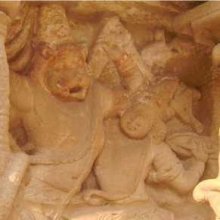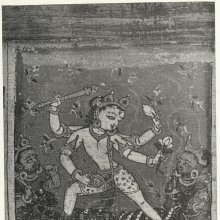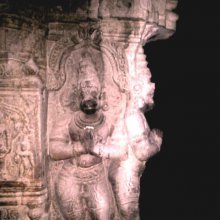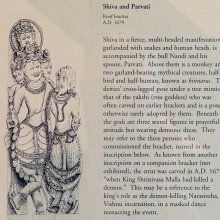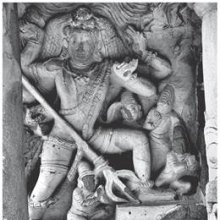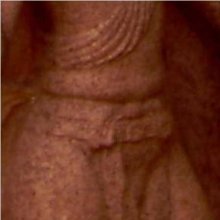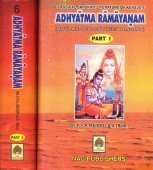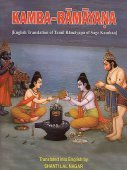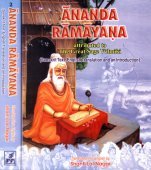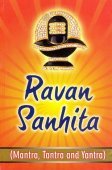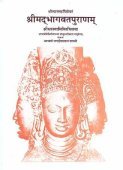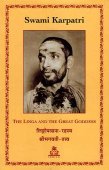Killing, Killed: 3 definitions
Introduction:
Killing means something in Hinduism, Sanskrit, the history of ancient India. If you want to know the exact meaning, history, etymology or English translation of this term then check out the descriptions on this page. Add your comment or reference to a book if you want to contribute to this summary article.
Images (photo gallery)
(+14 more images available)
In Hinduism
Yoga (school of philosophy)
Source: ORA: Amanaska (king of all yogas): A Critical Edition and Annotated Translation by Jason BirchThe Killing (of adversaries) is known in the Sanskrit language as Māraṇa, according to the Amanaska Yoga treatise dealing with meditation, absorption, yogic powers and liberation.—Accordingly, as Īśvara says to Vāmadeva: “[...] By astonishing, [magical] feats such as [creating] enmity [among friends], driving off and killing (māraṇa) [adversaries] and by [tantric] mantras [of all kinds], [deluded] multiplicity multiplies. By all [yogic] practices, the various Bandhas and Mudrās, nothing but union with ignorance [is achieved]. Meditation on points in the body, the channels [of vitality] and the six Cakras is an error of mind. Therefore, having abandoned all that, [because it has been] constructed by the mind, resort to the no-mind [state]. [...]”.

Yoga is originally considered a branch of Hindu philosophy (astika), but both ancient and modern Yoga combine the physical, mental and spiritual. Yoga teaches various physical techniques also known as āsanas (postures), used for various purposes (eg., meditation, contemplation, relaxation).
Natyashastra (theatrics and dramaturgy)
Source: Shodhganga: Literary estimate of mudraraksasaKilling is denoted by the Sanskrit term Vadha, and should be avoided on a stage (where a dramatic play is performed).—A Nāṭaka should contain pañcasandhis which indicate five successive stages of the drama. This criterion also is present in the Mudrārākṣasa. [...] In the Sāhityadarpaṇa, Viśvanātha gives a list of certain actions which should not be presented on the stage. These are [e.g., Vadha (killing)] [...].

Natyashastra (नाट्यशास्त्र, nāṭyaśāstra) refers to both the ancient Indian tradition (shastra) of performing arts, (natya—theatrics, drama, dance, music), as well as the name of a Sanskrit work dealing with these subjects. It also teaches the rules for composing Dramatic plays (nataka), construction and performance of Theater, and Poetic works (kavya).
India history and geography
Source: Singhi Jain Series: Ratnaprabha-suri’s Kuvalayamala-katha (history)Killing (of a tiger) (with bull horns) represents a scene of animal life commonly depicted on the Saṃsāracakra paintings, in ancient India, as mentioned in the Kathās (narrative poems) such as Uddyotanasūri in his 8th-century Kuvalayamālā (a Prakrit Campū, similar to Kāvya poetry).—Page 185.21 f.: Here follows a description of a printed scroll illustrating the Jaina conception of saṃsāracakra. [...] The saṃsāra-cakra illustrated the three worlds of hell, human world and the world of gods. [For example:] Fight between a tiger and a wild bull, and killing of a tiger with bull horns.

The history of India traces the identification of countries, villages, towns and other regions of India, as well as mythology, zoology, royal dynasties, rulers, tribes, local festivities and traditions and regional languages. Ancient India enjoyed religious freedom and encourages the path of Dharma, a concept common to Buddhism, Hinduism, and Jainism.
See also (Relevant definitions)
Ends with: Refrain from killing.
Full-text (+3287): Marana, Hanana, Hata, Vadha, Vadhya, Vyapadana, Nishumbha, Hatya, Kadana, Pramapana, Sudana, Nisudana, Nihanana, Samjnapana, Brahmahatya, Goghna, Nistarhana, Marita, Nirgranthana, Nikarana.
Relevant text
Search found 394 books and stories containing Killing, Killed; (plurals include: Killings, Killeds). You can also click to the full overview containing English textual excerpts. Below are direct links for the most relevant articles:
Bihar and Eastern Uttar Pradesh (early history) (by Prakash Narayan)
Buddhism and Cattle Sacrifice < [Chapter 2 - Economic and Urban Processes]
Vedic Sacrifices and Cattle Wealth < [Chapter 2 - Economic and Urban Processes]
Material Growth and the ruling class < [Chapter 2 - Economic and Urban Processes]
A Leaf From Our Cultural Heritage < [April – June, 1998]
Gandhi and I < [October – December, 1983]
Remember, Remember < [April – June, 2002]
Trishashti Shalaka Purusha Caritra (by Helen M. Johnson)
Part 19: Future of Gośāla < [Chapter VIII - Initiation of ṛṣabhadatta and devānandā]
Part 8: Story of origin of animal sacrifices < [Chapter II - Rāvaṇa’s expedition of Conquest]
Part 10: The killing of Kaṃsa < [Chapter V - Birth of Rāma, Kṛṣṇa, and Ariṣṭanemi]
Manusmriti with the Commentary of Medhatithi (by Ganganatha Jha)
Verse 11.134 < [Section XV - Expiation for the killing of Cats and other Animals]
Verse 11.136 < [Section XV - Expiation for the killing of Cats and other Animals]
Verse 11.126 < [Section XIV - Expiation for the killing of a Kṣatriya, or a Vaiśya or a Śūdra]
Shrimad Bhagavad-gita (by Narayana Gosvami)
Verse 2.19 < [Chapter 2 - Sāṅkhya-yoga (Yoga through distinguishing the Soul from the Body)]
Verse 1.36 < [Chapter 1 - Sainya-Darśana (Observing the Armies)]
Verse 1.31 < [Chapter 1 - Sainya-Darśana (Observing the Armies)]
Maha Prajnaparamita Sastra (by Gelongma Karma Migme Chödrön)
Story of Śakra’s question < [Chapter XXIV - The Virtue of Patience]
Part 2 - The origins of Rājagṛha < [Chapter V - Rājagṛha]
Appendix 3 - Suicide in Buddhism (ātmavadha) < [Chapter XX - The Virtue of Generosity and Generosity of the Dharma]
Related products
(+4 more products available)
